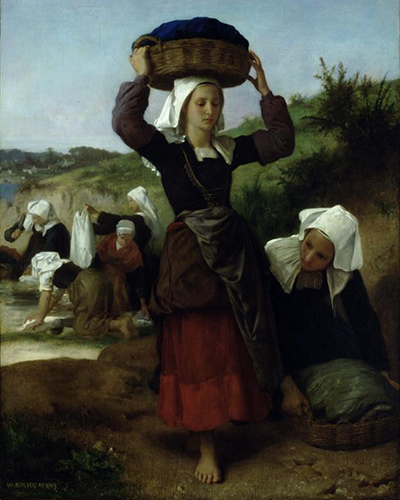"The Washerwomen of Fouesnant" is one of the popular paintings by William-Adolphe Bouguereau (1825-1905), the famous French artist. The painting depicts a typical everyday scene in Fouesnant, a bay in Brittany.
A group of peasants are going on with their daily chores. The most prominent figure is leaving the scene, carrying a basket of laundry on her head, whereas the other peasants are in various stages of washing their clothes.
"The Washerwomen of Fouesnant" painting exemplary of Bouguereau ‘s style and talent, as evident from the attention to detail, and being grounded in reality. Bouguereau was a doyen of the neoclassical school, and true to style, “The Washerwomen of Fouesnant” features a strong neoclassical influence. For the neoclassical painters, the peasants who perform their typical daily chores are counterparts of ancient rustic figures, dating back to Greek mythology.
Bouguereau too drew inspiration from Greek mythology for this painting, as evident from the dominating figure in the painting. The girl carrying the laundry on her head bears striking resemblance to caryatid, the classical figure who supports an architectural pediment. Bouguereau is at his best here in his ability to delve into ancient Greco-Roman mythology, and depict it in contemporary themes.
Another striking feature of “The Washerwomen of Fouesnant” is its realism. Whereas traditional academic painters depict peasants in a utopian state of being clean, neatly dressed, and well-fed, Bouguereau presents life as is it, in a realistic setting. As it is with many of his works, “The Washerwomen of Fouesnant” depicts real life in real settings, as Bouguereau saw in person. The ability to express realism in a perfect way makes Bouguereau a cut above the rest, and explains his popularity.
“The Washerwomen of Fouesnant” was drawn in 1869, when Bouguereau was at the peak of his powers and fame. His travels across France gave him inspiration and theme for his paintings.
William Bouguereau was the most popular French painter of his time, having executed more than 822 works, most of which were widely received, and received top billing. He received several awards and honours throughout his life, including several Legion of Honour awards.




